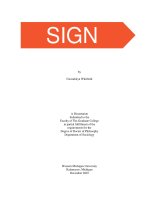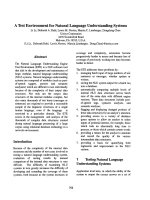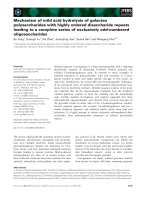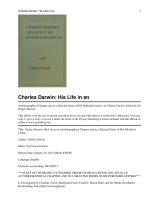R a test series praveen chikara
Bạn đang xem bản rút gọn của tài liệu. Xem và tải ngay bản đầy đủ của tài liệu tại đây (1.27 MB, 48 trang )
TABLE OF CONTENTS
Real Analysis Test 1……………………………………………….……. [#]
Topics: Set theory, Countable Sets, Sequences and Series.
Real Analysis Test 2……………………………………………….……. [#]
Topics: Continuity, Uniform Continuity, Differentiability.
Real Analysis Test 3……………………………………………….……. [#]
Topics: Uniform Convergence, Riemann Integration.
Real Analysis Test 4……………………………………………….……. [#]
Topics: Metric Spaces, Functions of Several Variables.
Real Analysis Test 5……………………………………………….……. [#]
Topics: : Set theory, Countable sets, Sequences and Series, Point-set topology,
Continuity, Uniform Continuity, Differentiability, Uniform Convergence,Riemann
Integration, Metric Spaces..
12 thousand via teaching, social
social m
Mar 30, 2019
www.pdfgrip.com
ra
ika
Pr
a
ve
en
C
hh
Real Analysis Test-1
1
www.pdfgrip.com
Real Analysis Test-1
“Be transparent. Let’s build a community that allows hard questions and
honest conversations so we can stir up transformation in one another.” Germany Kent
Time duration: 80 minutes
Max. points: 99
-Praveen Chhikara
Topics: Set theory, Countable Sets, Sequences and Series
Instructions:
ra
1. There are two sections, first of “Single-correct questions” and second
of “Multi-correct questions”.
ika
2. Each question of the first section has one correct option. One question
carries 3 marks, and a wrong choice leads to NEGATIVE 0.75 marks.
1
Ch
h
3. Each question of the second section has one or more correct option(s).
One question carries 4.75 marks, and there is no negative marking in
this section.
Single-correct Questions
1. Which of the following is a one-to-one function f : R → R?
(a) f (x) = |x|.
ve
en
(b) f (x) = cos x2 .
(c) f (x) =
x2
.
x2 +1
(d) f (x) =
x|x|
.
x2 +1
n
2. The sequence n. n
k=1
sin( k1 )
Pr
a
(a) is unbounded.
(b) is bounded but not convergent.
(c) is convergent and its limit is e.
(d) is convergent and its limit is 1/e.
2
www.pdfgrip.com
3. Consider a sequence (an ) in R. Then
(a) if all convergent subsequences of (an ) converge to 0, then (an ) → 0.
(b) if all monotone subsequences of (an ) are convergent, then (an )
must be bounded.
(c) (an ) is divergent if, and only if all of its subsequences are divergent.
(d) If (an ) diverges, then all of its subsequences diverge.
4. Which of the following is an incorrect statement?
∞
∞
(a) If
a3n must
an is a convergent series of positive terms, then
n=1
n=1
be convergent.
∞
∞
√
an is a convergent series of positive terms, then
ra
(b) If
n=1
is convergent.
∞
∞
an and
n=0
n=0
k
ck =
al bk−l .
l=0
∞
∞
an and
n=1
bn are convergent series of positive terms, then
n=1
∞
so is
ck , where
k=0
hh
(d) If
∞
bn are convergent series, then so is
ika
(c) If
an an+1
n=1
an b n .
n=1
en
C
5. A sequence (an ) of real numbers is said to be of bounded variation if
∞
|an − an−1 | converges. Then
the series
n=2
(a) every convergent sequence is of bounded variation.
(b) every monotone convergent sequence is of bounded variation.
ve
(c) if (an ) and (bn ) are of bounded variation, then (an − bn ) may not
be of bounded variation.
Pr
a
(d) if (an ) and (bn ) are of bounded variation, then (an bn ) may not be
of bounded variation.
6. Let V be a vector space of all bounded real sequences x = (xn )which
converge to zero. Define
x 1 = sup{| xn |: n ∈ N} and x 2 = inf{| xn |: n ∈ N}. Then
(a) if x = y, then
x−y
1
may be zero.
3
www.pdfgrip.com
(b) for every x ∈ V , there must exists an n0 ∈ N such that xn0
= x 1.
(c) for every x ∈ V , there must exists an n0 ∈ N such that xn0
= x 2.
(d) the dimension of V is uncountable infinite.
7. Let A, B ⊆ R be nonempty sets. Which of the following is wrong?
(a) P (A) ∩ P (B) = P (A ∩ B).
(b) P (A) ∪ P (B) ⊆ P (A ∪ B).
(c) P (A) ∪ P (B) = P (A ∪ B).
(d) P (A ∩ B) ⊆ P (A) ∩ P (B).
ra
.
8. Let us define the density of A ⊆ N with respect to N equal to lim |{x∈A:x≤n}|
n
n→∞
Then
ika
(a) the density of the set {2, 4, 6, ...} is 2.
(b) there exists a finite subset of N with positive density.
(c) if the density of a set is zero, then it must be a finite set.
9. Let A :=
mn
1+m+n
hh
(d) for each 0 ≤ α ≤ 1, there exists a set with density equal to α.
: m, n ∈ N . Then
(a) sup A < 1 and inf A = 1/3.
en
C
(b) sup A ∈ A and inf A ∈
/ A.
(c) sup A = 1 and inf A = 0.
(d) sup A does not exist and inf A ∈ A.
ve
10. Let A be the collection of all circles in the complex plane having rational
radii and centers with rational coordinates. Let B be the collection of
disjoint intervals of positive length. Then
(a) A is countable but B is uncountable.
(b) B is countable but A is uncountable.
Pr
a
(c) both A and B are countable.
(d) both A and B are uncountable.
11. Let f : X → Y be a function. Pick the odd statement.
(a) f (A ∩ B) = f (A) ∩ f (B), for all A, B ∈ X.
4
www.pdfgrip.com
(b) f −1 (f (A)) = A, for all A ⊆ X.
(c) there exists a, b ∈ X such that a = b, f (a) = f (b).
(d) for all disjoint A, B ⊆ X, f (A) ∩ f (B) = ∅.
12. The range of the function f : R → R, defined by f (x) =
[.] denotes the greatest integer function,
x−[x]
,
1+x−[x]
where
(a) has its supremum equal to 1.
(b) does not have its minimum element.
(c) is unbounded below.
(d) does not have its maximum element.
sin n1 .
(b)
n2 .
(c)
1
.
n2
1
.
n
(d)
ika
(a)
ra
13. Pick the series which converge.
(a) 2m .
(b) 2m − 1.
(c) 2m − 2.
ve
en
(d) 2m − 4.
Ch
h
14. If |A| = m, |B| = 2, then the number of onto functions from A to B is
2
Multi-correct Questions
√
15. Consider a sequence (an ), where an = ( 1+2 5 )n . Define a sequence (bn )
by bn = d(an , Z) where d(an , Z) = inf{d(an , x) : x ∈ Z}. Then
(a) the sequence (an ) is not convergent.
Pr
a
(b) the sequence (bn ) is convergent.
(c) the sequence (bn ) is bounded.
(d) the sequence ( a1n ) is convergent.
16. Let (an ) be a sequence given by an = nα sin n, where α ∈ R. Then
5
www.pdfgrip.com
(a) (an ) has a convergent subsequence, for α = 1/2.
(b) (an ) does not have a bounded subsequence, for α = 3/2.
(c) (an ) has a convergent subsequence, for all α < 0.
, 1 ), there exists a subsequence (ank ) of
(d) for α = 0, and c ∈ ( −1
2 2
(an ), such that ank → c.
17. Let
an be a series with real-valued terms. Define
|an | + an
|an | − an
, qn :=
, n ∈ N.
2
2
Which of the following hold(s) true?
pn :=
pn and
(b) If
an is conditionally convergent, then one of
may converge.
pn and
ra
(a) If
an is conditionally convergent, then both
diverge.
(c) If
|an | is convergent, then both
(d) If
|an | is convergent, then one of
ika
pn and
pn and
qn
qn
qn converge.
qn may diverge.
hh
18. Let (an ) be a bounded sequence in R. Suppose S denotes the range of
(an ). Then
(a) there exist convergent and monotone subsequences (ank ) and (amk )
such that lim |ank − amk | = sup S − inf S.
n→∞
en
C
(b) if (an ) is divergent, there exist convergent and monotone subsequences (ank ) and (amk ) such that lim |ank − amk | > 0.
n→∞
(c) there exist an α ∈ R such that for every m ∈ N and
exists an n0 > m such that |an0 − α| < .
> 0 there
ve
(d) the collection {x ∈ R : there exists a subsequence (ank ) of (an )
such that (ank ) → x} is a compact set.
Pr
a
19. Let G be a group of all maps from the closed interval [0, 1] to Z. The
subgroup H = {f ∈ G : f (0) = 0}
(a) is countable.
(b) is uncountable.
(c) has countable index.
(d) has uncountable index.
6
www.pdfgrip.com
20. Which of the following series is(are) convergent?
(a)
(b)
(c)
(d)
1
tan−1 (n)].
π
√
sin(n− n2 +n)
.
n
n
1+5
.
1+6n
√
sin n
√
.
n
[ 12 −
21. Let a, b ∈ Z. The functions f : N × N → N and g : Z × Z → Z given
by f (x, y) = 2x−1 (2y − 1) and ga,b (x, y) = ax + by respectively. Then
(a) f is one-to-one.
(b) f is onto.
ra
(c) there exists a, b ∈ Z such that ga,b is onto.
(d) there exists a, b ∈ Z such that ga,b is one-to-one.
ika
22. Which of the following statement(s) is(are) true in relation to the
Cauchy sequences in R?
(a) There exists a Cauchy sequence with rational terms converging to
eπ .
hh
(b) If (an ) is Cauchy, and its subsequence converges to α, then (an ) →
α.
en
C
(c) There exists a Cauchy sequence for which there exist two subsequences, converging to two distinct point.
(d) For each Cauchy sequence, there exists a monotone convergent
subsequence.
23. Consider the series
Then
bn , where an =
1
n(log n)4
an is convergent.
ve
(a)
an and
an has the bounded sequence of partial sums.
(c)
bn has the bounded sequence of partial sums.
(d)
bn has a convergent sub-series.
Pr
a
(b)
24. Which of the following sets is(are) uncountable?
√
(a) { 2x : x ∈ Q}.
√
(b) {x + 2y : x, y ∈ Z}.
7
www.pdfgrip.com
and bn =
1
.
n
(c) a nonempty open set in R.
(d) { 2mn : m, n ∈ Z}.
n
25. Let (an ) be a real sequence defined by an :=
k
( k1 + sin
− log n). Then
k2
k=1
(a) (an ) converges.
∞
(b)
an does not converge.
n=1
n
(c) (an −
k=1
∞
(d)
sin k
)
k2
n
(an −
k=1
sin k
)
k2
does not converge.
ra
n=1
converges to zero.
26. Which of the following hold(s) for real sequences (an ) and (bn )?
ika
(a) If (an ) and (an bn ) are convergent, then so is (bn ).
(b) If (an ) and (bn ) are unbounded, then so is (an + bn ).
(c) If (an ) is unbounded, an = 0, then ( a1n ) may be bounded.
(d) If (an ) is unbounded, then lim |an | = ∞.
hh
n→∞
Answer Key
ve
en
C
Single-Correct Questions
1. D
2. C
3. B
4. C
5. B
6. B
7. C
8. D
9. D
10. C
11. C
12. D
13. C
14. C
Multi-Correct Questions
15. A,B,C,D
16. A,C,D
17. A,C
18. A,B,C,D
19. B,C
20. C
21. A,B,C
22. A,B,D
23. A,B,D
24. C
25. A,
B,D
26. C
Pr
a
Best Wishes from Praveen Chhikara...
8
www.pdfgrip.com
ra
ika
Pr
a
ve
en
C
hh
Real Analysis Test-2
1
www.pdfgrip.com
Real Analysis Test-2
“The sole meaning of life is to serve humanity” - Leo Tolstoy
Time duration: 80 minutes
Max. points: 115.50
-Praveen Chhikara
Topics: Continuity, Uniform Continuity, Differentiability
Instructions:
ra
1. There are two sections, first of “Single-correct questions” and second
of “Multi-correct questions”.
ika
2. Each question of the first section has one correct option. One question
carries 3 marks, and a wrong choice leads to NEGATIVE 0.75 marks.
1
Ch
h
3. Each question of the second section has one or more correct option(s).
One question carries 4.75 marks, and there is no negative marking in
this section.
Single-correct Questions
1. Suppose f : R → R is a function and F := {x ∈ R : f (x) > 0}. Then
find the valid statement.
ve
en
(a) There exists a continuous function f for which F is infinite and
contains no open interval.
(b) There exists a continuous function f for which F is a countable
infinite set.
(c) There exists a continuous function f for which F is finite with
more than one element.
(d) If f is continuous, and F = ∅, then F is uncountable.
Pr
a
2. Which of the following statements implies the continuity of the function
f : R → R?
(a) f 2 is continuous.
(b) f (f (x)) is continuous.
2
www.pdfgrip.com
(c) ef (x) is continuous.
(d) |f | is continuous.
3. Let f : R → R be a monotone function. The cardinality the set of
{a ∈ R : lim− f (x) = lim+ f (x)} cannot be
x→a
x→a
(a) equal to zero.
(b) equal to that of the open interval (0, 1).
√
(c) equal to that of Z[ 2].
(d) equal to that of N × N.
ra
4. Suppose y ∈ R. Let fy : R → R be a function defined by
fy (x) = d(x, y), where d(x, y) = |x − y|. Then
(a) fy is not continuous for some y ∈ R.
(b) fy is uniformly continuous for all y ∈ R.
ika
(c) there exists a y ∈ R such that fy is differentiable.
(d) fy is a bounded function for all y ∈ R.
hh
5. Which of the following statements is true?
(a) A continuous function f : R → R that is one-to-one must be
unbounded.
en
C
(b) A continuous function f : R → R that is one-to-one must be
differentiable.
(c) A continuous function f : R+ → R that is onto must satisfy
lim |f (x)| = ∞.
n→∞
(d) A continuous function f : R → R that is one-to-one must be
strictly monotone.
ve
6. Suppose f : (0, ∞) → R is differentiable and |f (x)| < 1. Then
(a) (an ), where an = f ( 32 )n , is not convergent.
Pr
a
n
(b) (bn ), where bn = f ( n+1
), is not convergent.
(c) (cn ), where cn = f ( n1 ), is convergent.
(d) there exists an x0 > 0, such that f (x0 ) = x0 .
3
www.pdfgrip.com
7. Suppose A := {x ∈ [0, 1] : x = 2mn for some m ∈ Z, n ∈ N} and
√
B := Z[ 2] ∩ [0, 1]. Let f : [0, 1] → R be a function defined by
3
x + 2 ; for x ∈ A
f (x) = 2x + 1; for x ∈ B
2;
otherwise.
Then
(a) f is continuous at all points x ∈
/ A ∪ B.
(b) f is discontinuous at each point of its domain.
(c) f is differentiable at exactly one point of its domain.
ra
(d) f is continuous at exactly one point but differentiable nowhere.
ika
8. Suppose f : (a, b) → R is differentiable and |f (x)| = 0 for x ∈ (a, b).
Then
(a) f need not be one-to-one.
(b) f is strictly monotone.
(c) f is bounded.
hh
(d) there exists some c, d ∈ (a, b) such that f (c)f (d) < 0.
9. Suppose f : [0, 1] → R is a function and S is the range of f . Then
en
C
(a) If f is strictly increasing, then S may be a subset of Q.
(b) If f is increasing, then S may be a unbounded.
(c) If f is strictly increasing and continuous, then S may be a subset
of Q.
ve
(d) If f is strictly increasing and continuous, then S cannot be a subset
of R \ Q.
10. Let f : R → R be a differentiable function. Suppose f (0) = 1 and
f (x) ≤ 5 for all x ∈ (0, 7). Then f (2) is atmost equal to
Pr
a
(a) 9
(b) 10
(c) 11
(d) 12
4
www.pdfgrip.com
2
Multi-correct Questions
11. For E ⊂ R, consider the following statements:
P : Every continuous function f : E → R is uniform continuous.
Q: E is compact.
R: Every continuous function f : E → R is bounded.
Which of the following is(are) false?
(a) R
P
(b) P ⇒ Q
(c) Q ⇒ P
(d) R ⇒ Q
(a) at least two solutions in R.
ika
(b) at most two solutions in R.
ra
12. The equation x sin x + cos x − x2 = 0 has
(c) exactly one positive real solution.
(d) exactly one negative real solution.
hh
13. Let f : [0, ∞) → R be a continuous function. Suppose that f is
differentiable for all x > 0 and that lim f (x) = 0. Further suppose
x→∞
lim (f (x) + f (x)) exists finitely. Then
x→∞
en
C
(a) lim+ f ( x1 ) exists.
x→0
(b) f must be a uniform continuous function.
(c) lim+ f (x) exists.
x→0
(d) f must be a bounded function.
ve
14. For A ⊆ R, the function f : A → R, f (x) = x2 is a uniform continuous
function if
Pr
a
(a) A is bounded.
(b) A is unbounded.
(c) A is compact.
(d) A is the set Z of all integers.
15. Let T : Rn → Rm be a linear transformation. Then
5
www.pdfgrip.com
(a) T need not be continuous.
(b) T is differentiable.
(c) T is differentiable but not continuously differentiable.
(d) the partial derivatives of T need not exist.
16. Which of the following is(are) correct inequality(ies)?
(a) ex ≥ ex ∀ x ∈ R.
(b)
x
1+x
x
≤ log(1 + x) ∀ x > 0.
y−x
y
≤ log xy for 0 < x < y.
(c) e ≥ 1 + x ∀x ∈ R
(d)
ra
17. Let f : R → R be a continuous and periodic function. Then
(a) f attains its supremum.
ika
(b) f need not be bounded.
(c) there do not exist sequences (xn ) and (yn ) in R such that
|xn − yn | → 0 but |f (xn ) − f (yn )|
0.
hh
(d) if (xn ) is a Cauchy sequence in R, then (f (xn )) is also a Cauchy
sequence.
18. Let f : [0, 1] → R be a bounded function. Which of the following may
be true statement(s)?
en
C
(a) f attains infimum but not supremum.
(b) f attains supremum but not infimum.
(c) f attains neither an infimum nor a supremum.
(d) f attains its supremum and infimum on any nonempty open interval A ⊂ [0, 1].
ve
19. Let f : R → R be the characteristic function of the Cantor set C.
Then,
(a) lim f (x) = 1, if a ∈ C.
Pr
a
x→a
(b) lim f (x) = 0, if a ∈
/ C.
x→a
(c) f is continuous at a if a ∈ C.
(d) f is continuous at a if a ∈
/ C.
6
www.pdfgrip.com
20. A function f : R → R is said to be symmetrically continuous at x ∈ R
if lim [f (x + h) − f (x − h)] = 0. Which of the following is(are) true?
h→0
(a) There exists a continuous function at x which is not symmetrically
continuous at x.
(b) A symmetrically continuous function at x must be continuous at
x.
(c) If f is symmetrically continuous at x, then lim
h→0
f (x+h)−f (x−h)
h
= 0.
(d) A differentiable function must be symmetrically continuous at all
x ∈ R.
ra
21. Suppose IVP refers to the Intermediate Value Property of functions.
Let f : (a, b) → R be a function. Suppose A = {y ∈ R : card({x : f (x) =
y}) = ∞}. Which of the following is(are) true?
(a) if f is strictly monotone, then A must be empty.
ika
(b) if f has IVP on (a, b) and is discontinuous, then A must be
nonempty.
(c) if f has IVP, then A can be non-compact.
hh
(d) if f has IVP, then A can be compact.
22. Let f : R → R be a continuous function. Then
en
C
(a) if f is uniformly continuous on both (−∞, 0] and [0, ∞), then f
is uniformly continuous on R.
(b) if f is uniformly continuous on both (−∞, 0] and [1, ∞), then f
is uniformly continuous on (−∞, 0] ∪ [1, ∞).
(c) if f is uniformly continuous on each of the compact sets X1 , X2 , . . . , Xn ,
n
then f is uniformly continuous on
Xi .
i=1
ve
(d) if f is uniformly continuous on each of the compact intervals
∞
X1 , X2 , . . . , Xn , . . ., then f is uniformly continuous on
Xi .
i=1
Pr
a
23. Which of the following is(are) true about real-valued functions?
(a) There exists a strictly monotone function f on [0, 1] that is discontinuous at each point of (0, 1)∩Q and continuous at each point
of (0, 1) ∩ (R \ Q).
7
www.pdfgrip.com
(b) If f is continuous on an open interval and has no local maximum
or local minimum, then f must be monotone.
(c) There exists a monotone function on [0, 1] that is discontinuous
only at points of (0, 1) ∩ (R \ Q).
(d) If f : [a, b] is monotone, then f must be a continuous on an uncountable dense set of [0, 1].
24. Let f : I → R be a function where I be a nondegenerate interval in R.
We define the oscillation of f on I by ωf (I) = sup |f (x) − f (y)| and
x,y∈I
oscillation of f at x0 ∈ I by ωf (x0 ) = inf ωf ((x0 − δ, x0 + δ)).
δ>0
(b) ωf (I) = sup f (x) − inf f (x).
x∈I
x∈I
ra
(a) f is continuous at x0 ∈ I if, and only if ωf (x0 ) = 0.
(c) ωf (x0 ) = lim sup f (x) − lim inf f (x).
x→x0
x→x0
ika
(d) ωf (x0 ) = lim+ ωf ((x0 − δ, x0 + δ)).
δ→0
25. Pick the correct statement(s).
Ch
h
(a) There exists a function f : R → R such that
f (x) =
0; if x < 0
1; if x > 0.
ve
en
(b) If f : R → R is differentiable and there is an M > 0 such that
|f (x)| < M ∀ x ∈ R, then there exists an > 0 for which x+ f (x)
is a one-to-one function.
(c) If f : (a, b) → R is differentiable, then f (x) = lim
h→0
(d) If f : (a, b) → R is a function such that lim
h→0
f (x+h)−f (x−h)
.
2h
f (x+h)−f (x−h)
2h
exists
for all x ∈ (a, b), then f is a differentiable function.
Pr
a
26. Let f : R → R be a differentiable function. If f (x) = 1 for all x ∈ R,
then
(a) f has at least one fixed point.
(b) f may have more than one fixed point.
(c) f has a unique fixed point.
(d) f may have no fixed point.
8
www.pdfgrip.com
27. Let f : [a, b] → R be a differentiable function. Suppose there does not
exist any x ∈ [a, b] for which f (x) = f (x) = 0.
Let A := {x ∈ [a, b] : f (x) = 0} be nonempty. Then A
(a) is closed.
(b) is compact.
(c) is necessarily finite.
(d) may be open.
ra
28. Suppose C denotes the Cantor set. Consider the function f : [0, 1] → R
defined by
1; if x ∈ C,
f (x) =
0; if x ∈
/ C.
Then
(a) if a ∈ C, lim f (x) exists.
ika
x→a
(b) f is continuous at uncountable number of points.
(c) f is discontinuous at most countable infinite number of points.
hh
(d) f is differentiable no-where.
Answer Key
ve
en
C
Single-Correct Questions
1. D
2. C
3. B
4. B
5. D
6. C
7. D
8. B
9. D
10. C
Multi-Correct Questions
11. A,B.
12. A,B,C,D
13. A,B,D
14. A,B,C,D
15. B
16. A,B,C,D
17. A,C,D
18. A,B,C,D
19. B,D
20. D
21. A,C,D
22. A,B,C
23. A,B
24. A,B,D
25. B,C
26.
A,C
27. A,B,C
28. B,D
Pr
a
Best Wishes from Praveen Chhikara...
9
www.pdfgrip.com
ra
ika
Pr
a
ve
en
C
hh
Real Analysis Test-3
1
www.pdfgrip.com
Real Analysis Test-3
“Every great dream begins with a dreamer. Always remember, you have
within you the strength, the patience, and the passion to reach for the stars
to change the world.” - Harriet Tubman
Time duration: 55 minutes
Max. points: 81
-Praveen Chhikara
Topics: Uniform Convergence, Riemann Integration
Instructions:
ra
1. There are two sections, first of “Single-correct questions” and second
of “Multi-correct questions”.
ika
2. Each question of the first section has one correct option. One question
carries 3 marks, and a wrong choice leads to NEGATIVE 0.75 marks.
1
Ch
h
3. Each question of the second section has one or more correct option(s).
One question carries 4.75 marks, and there is no negative marking in
this section.
Single-correct Questions
1. Let (fn ) be a sequence of functions on [0, 1] defined by
ve
en
fn (x) =
n; if 0 < x < n1
0; if x = 0 or x ≥ n1 .
Suppose (fn ) → f. Then
1
(a) lim
n→∞ 0
fn (x)dx = 0.
1
(b)
f (x)dx = 0.
Pr
a
0
(c) (fn ) → f uniformly on [0, 1].
1
(d)
fn converges uniformly on [0, 1].
0
2
www.pdfgrip.com
2. Suppose f : [−1, 1] → R is a function given by
1; if x = 1,
0; if x = 1.
f (x) =
If g is the indefinite integral of f , then
(a) g is not of bounded variation on [−1, 1].
(b) g is differentiable at x = 1.
(c) g is not Riemann integrable on [0, 1].
(d) g is not continuous on [0, 1].
ra
3. Suppose for n ∈ N,
ika
if x ≤ 0,
0;
fn (x) = nx; if 0 ≤ x ≤ n1 ,
1;
if x ≥ n1 .
The sequence (fn ) of functions
(a) converges to the zero function on [0, 1].
Ch
h
(b) converges uniformly on [0, 1].
(c) converges to a function which is discontinuous at x = 1.
(d) converges to a non-differentiable function on [0, 1].
∞
4. For the series
n=1
cos(2n x)
2n
for all x ∈ R, which of the following is false?
ve
en
(a) The series converges uniformly on R.
(b) The sum of the series is continuous on R.
(c) The sum of the series is monotone in some nonempty interval of
R.
(d) The sum of the series is not differentiable at any point of R.
Pr
a
5. Suppose that f : [a, b] → R is Riemann integrable. Let F (x) =
x
f (t)dt. Which of the following is correct?
a
(a) If f is discontinuous at x0 ∈ [a, b], then F (x) is discontinuous at
x0 .
3
www.pdfgrip.com
(b) Even if f is discontinuous at x0 ∈ [a, b], F (x) is continuous at x0
but is not differentiable at x0 .
(c) The function F (x) is continuous but not necessarily a Lipschitz
function on [a, b].
(d) F (x), if it exists, need not be equal to f (x).
6. Let {α1 , α2 , . . .} be an enumeration of the set Q of all rational numbers.
If (fn ) is a sequence of functions given by
fn (x) =
1, if x ∈ {α1 , . . . , αn }
0, otherwise.
ra
Then
(a) (fn ) converges uniformly on [0, 1].
(b) (fn ) converges to a Riemann integrable function on [0, 1].
ika
(c) f (x) = lim lim cos2m (n!πx) for all x ∈ R.
n→∞ m→∞
(d) f (x) = lim fn (x) is a function of bounded variation on [0, 1].
n→∞
Ch
h
7. Let f : [0, 1] → R be a bounded function. Suppose ℘[0, 1] denotes
the collection of all partitions of [0, 1]. Further suppose U (f, P ) and
L(f, P ) denote respectively the upper sum and the lower sum of f for
P ∈ ℘[0, 1]. If there exist sequences (an ) in R and (Pn ) in ℘[0, 1] such
that
U (f, Pn ) − L(f, Pn ) < an ,
ve
en
then which of the following guarantees the Riemann integrability of f
on [0, 1]?
(a) an =
(b) an =
(c) an =
n
.
2n+1
n
.
log n
n
.
n+1
(d) an , where
|an | < ∞.
Pr
a
8. Consider the series
∞
f (x) =
n=0
xn
on (−1, 1).
n
Then
4
www.pdfgrip.com
(a) f is not continuous at all x ∈ (−1, 1).
(b) f is continuous but need not be differentiable at all x ∈ (−1, 1).
∞
(c) f (x) =
xn−1 for all x ∈ [−α, α] where, α is any element of
n=1
(0, 1).
(d) the given series is not uniformly convergent on [−α, α] for some α ∈
(0, 1).
2
Multi-correct Questions
1
9. Let f : [0, 1] → R be a continuous function. Suppose
g(x)f (x)dx =
ra
0
0 for each continuous function g : [0, 1] → R. Then
(a) f must be differentiable everywhere.
ika
(b) f need not be Riemann integrable on [0, 1].
(c) f must be Riemann integrable but need not be of bounded variation on [0, 1].
hh
(d) f must be continuous.
x
10. Suppose (fn ) is a sequence of functions on R given by fn (x) = 1+nx
2 for all x ∈
R. Let f (x) = lim fn (x) and g(x) = lim fn (x) for all x ∈ R. Then
n→∞
n→∞
en
C
(a) (fn ) converges uniformly on R.
(b) (fn ) converges uniformly on R.
(c) f (0) = g(0).
(d) f (a) = g(a) for some nonzero real number a.
ve
11. Let fn , n ∈ N and f be differentiable functions with fn → f on [0, 1].
Suppose f is bounded and Riemann integrable. Then which of the
1
following ensure(s) that lim
n→∞ 0
1
fn =
f?
0
Pr
a
1
(a)
fn converges uniformly on [0, 1].
0
(b) fn → f uniformly on [0, 1].
(c) (fn ) does not converge uniformly on [0, 1] but it converges uniformly on [a, 1], for all a ∈ (0, 1).
5
www.pdfgrip.com
(d) (fn ) converges uniformly on [0, 1].
12. Which of the following function is(are) Riemann integrable on [0, 1]?
(a) f (x) = e−x .
(b) g(x) = sin x.
(c) h(x) = χQ .
(d) k(x) = |x|.
13. Which of the following is(are) uniformly convergent series?
(b)
n=1
∞
(c)
n=1
∞
(d)
n=1
rn cos nt, where r ∈ (−1, 1) on R.
x
n(1+nx2 )
sin
√nx
n
xn
n!
on R.
ra
n=1
∞
on R.
ika
∞
(a)
on [−a, a] where a ∈ (0, 1).
hh
14. Suppose f : [0, 1] → (0, ∞) is a continuous function. Then which of
the following is(are) false?
(a) f is of bounded variation on [0, 1] if, and only if f has bounded
derivative.
en
C
(b) f may be of bounded variation on [0, 1] if f is not Riemann integrable on [0, 1].
(c) f is of bounded variation on [0, 1] if f is continuous on [0, 1].
(d) 1/f is of bounded variation on [0, 1] if f is of bounded variation
on [0, 1].
Pr
a
ve
15. A function f : [a, b] → R is said to be absolutely continuous on [a, b] if
for every > 0, there exists a δ > 0 such that
n
|f (bk ) − f (ak )| <
k=1
for every n disjoint open subintervals (ak , bk ) of [a, b], n ∈ N and
n
(bk − ak ) < δ.
k=1
Choose the correct statement(s).
6
www.pdfgrip.com









